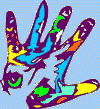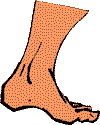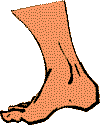 | Right Side/Left Side |  |
 | Right Side/Left Side |  |
| In 96% of
the population, the side of the brain that contains the area important for
language is the left side. People have
dominant parts of their bodies for other jobs too. For example, about 90%
of the population is right-handed. In other words, the right hand is
dominant...right-handed people prefer to use their right hand for most
tasks. What about the foot, eye and ear? Which foot is dominant? Which
eye? Which ear? The following set of experiments will help you find out if people have a dominant hand, foot, eye and ear. Print out one copy of this table for each person you will test. You will need to collect several items to test your subject. Also, do not tell your subjects what you trying to test. You can add more tests in each category (hand, foot, eye, ear) if you want. |

 | Right Hand/Left Hand |  |
First, let's check people for handedness...which hand do they prefer to
use in the following tests? Mark your data
sheet depending on whether
they use their right or left hand.
 Materials needed: Materials needed:
If you want to determine the STRENGTH of handedness,
there are two
different questionnaires you can use. | ||

 | Right Foot/Left Foot |  |
Now, let's check people for footedness...which foot do
they prefer to
use in the following tests? Mark your data sheet depending on whether
they use the right or left foot.
| ||

 | Right Eye/Left Eye |  |
Now, let's check people for eyedness...which eye do they prefer to
use in the following tests? Mark your data sheet depending on whether
they use the right or left eye.
| ||

 | Right Ear/Left Ear |  |
Now, let's check people for earedness...which ear do they prefer to use in
the following tests? Mark your data sheet depending on whether they use
the right or left ear.
| ||

| ||||||||||||||||||
| % of Men and Women who Use the RIGHT SIDE | ||
 | Men | Women |
| Hand | 86 | 90 |
| Foot | 77 | 86 |
| Ear | 55 | 65 |
| Eye | 73 | 69 |

Do you confuse your right and your left? |

|

| BACK TO: | The Senses | Experiments and Activities |
| BACK TO: | Exploring the Nervous System | Table of Contents |
![[email]](./gif/menue.gif) Send |
 Get Newsletter |
 Search Pages |
 Donate to Neuroscience for Kids |